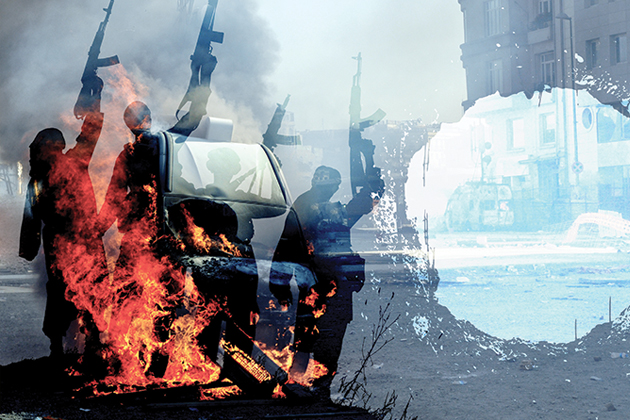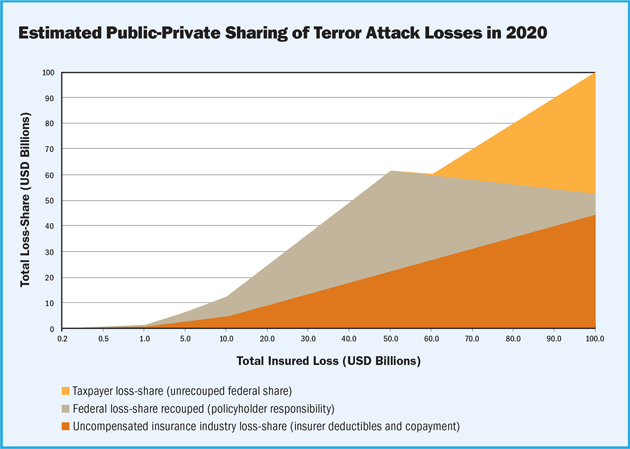
More than 13 years after the Terrorist Attacks of September 11, 2001, resulted in the loss of almost 3,000 lives and approximately $44 billion in insured losses (in 2014 dollars), the Terrorism Risk Insurance Act (TRIA) was reauthorized this year for a third time. Despite an initial delay by Congress, this latest reauthorization underlines the continued need for the federal backstop, and the structural changes made to the program as a result of the Terrorism Risk Insurance Program Reauthorization Act of 2015 must be considered as risk managers look to secure terrorism coverage going forward.
Since the Terrorism Risk Insurance Act (TRIA) was first passed in 2002, it has provided necessary stability to the private terrorism risk insurance market by guaranteeing both the availability and affordability of terrorism insurance coverage for U.S. commercial properties and businesses. Terrorism risk models have also emerged, enabling insurance industry stakeholders to better understand their exposure to this risk. Take-up rates for commercial property terrorism insurance coverage have risen from less than 30% in 2003 to just above 60% in 2013. Prices for terrorism risk insurance have also dropped as a result of the federal backstop and because of improved terrorism risk modeling capabilities.
Specialty engineering firms are now developing models that provide property owners, brokers and underwriters with better information for making actuarially sound decisions on terrorism insurance pricing and purchasing. These products provide a high-level estimate of building damage caused by accidental or terrorism-related explosions, and can be a starting point for a more detailed evaluation of threats, exposure and vulnerability. Read more in "Improving Terrorism Damage Modeling," also from the June 2015 issue of Risk Management.
While the re/insurance industry has become increasingly willing to cover terrorism risks, the private market still cannot assume all the risk alone. In the absence of TRIA, the capacity required to cover all the risk would lead to increased prices, making it difficult to obtain adequate coverage in areas most vulnerable to terrorism. With global terrorist organizations such as ISIS, al-Shabaab and al-Qaeda in the Arabian Peninsula (AQAP) continuing to make headlines by calling for attacks against Western interests, there remains the potential for a catastrophic terrorist attack on U.S. soil. Thus, the debate over the future of TRIA has continued.
Unfortunately, this latest reauthorization did not go as smoothly as expected. For the first time since TRIA was originally enacted, the program was allowed to expire, albeit briefly, at the end of 2014. The 11-day lapse had minimal impact on the insurance industry, however, as many anticipated the program’s reinstatement. Congress moved quickly to reauthorize the program, and, on Jan. 12, 2015, President Obama signed H.R. 26, the Terrorism Risk Insurance Program Reauthorization Act of 2015 (TRIPRA 2015), extending the federal backstop program for an additional six years through Dec. 31, 2020. As was the case with the 2007 reauthorization, TRIPRA 2015 calls for new structural changes that reduce the federal government’s role in the program.
Certification Requirement
Much like the TRIPRA 2007 program, TRIPRA 2015 requires that certain criteria are met to qualify for federal coverage. First, property/casualty insurance losses resulting from a terrorism-linked attack must meet the minimum damage certification level of $5 million. Even if losses are expected to meet this minimum threshold, the event must also be officially certified as an “act of terrorism.” This certification is determined by the secretary of the Treasury in concurrence with the attorney general and—new under TRIPRA 2015—the secretary of Homeland Security. The certification requirement can often be frustrating for policyholders, who are left wondering when or if their claims will be covered. For example, insured losses resulting from the Boston Marathon bombing were not expected to meet this minimum threshold, and the event has not been certified as an act of terrorism, even though President Obama referred to it as such during a speech he gave soon afterward.
If an act of terrorism has been officially certified, then compensation under the program still does not begin until aggregate insured losses in a calendar year reach the program trigger. Under TRIPRA 2015, the program trigger will gradually be raised each year from $100 million in 2015 to $200 million by 2020. The increase of the trigger is one of the most substantial changes to the program and aims to transfer more of the risk to the private insurance market. Some argue, however, that this may negatively impact the solvency of small, insufficiently diversified insurers that are not well positioned to absorb losses up to this level.

Insurer Share of Losses
Once all the initial criteria for federal coverage have been met, an insurer that incurs losses resulting from a certified act of terrorism is required to first cover a portion of the losses—the insurer deductible. The amount of each individual insurer’s deductible is calculated as 20% of the insurer’s direct earned premiums in TRIPRA-eligible lines of business for the previous calendar year. For losses in excess of the deductible, each insurer is also required to cover a pro-rata share of the losses, or copayment, while the federal government provides compensation for the remaining losses. Under TRIPRA 2015, the insurer copay will gradually increase each year from 15% until it reaches 20%.
An annual cap on liability still also applies under TRIPRA 2015, which means that no federal or private insurer payments are reimbursed for any portion of aggregate industry insured losses exceeding $100 billion. TRIPRA 2015 increases the industry annual aggregate retention from $29.5 billion to $37.5 billion in 2019, the fifth and penultimate year of the program. In 2020, the final year of TRIPRA 2015, the retention will rise to an amount equal to the average of all participating insurers’ deductibles over the previous three program years. The Congressional Budget Office (CBO) has estimated that this amount could be as much as $50 billion.
Insured Share of Losses
TRIPRA 2015 creates a public-private partnership for the sharing of insured losses resulting from a certified act of terrorism. The figure above examines how a range of loss levels are likely to be shared among the insurance industry, policyholders, and the federal government under the terms that will be in effect in 2020.
The actual loss-sharing is dependent on the total amount of the insurer deductibles, which is difficult to predict without knowing the number and size of the impacted insurers. Thus, for each of the total insured loss sizes shown in the figure, the total amount of the insurer deductibles was simply assumed to be 30%, but not more than $50 billion.
Under TRIPRA 2015, the industry retention set for the year 2020 will be equal to the average of the insurer deductibles over the previous three program years, or $50 billion, according to CBO estimates. Keep in mind that, until the uncompensated insurance industry loss-share (deductibles plus the 20% insurer copayment) reaches the industry retention of $50 billion, the federal government will recoup at least a portion of their loss through property/casualty policyholder surcharges in the years following the certified act of terrorism, which will be taxed at a rate of 140%.
While it is always at the discretion of the secretary of the Treasury to determine whether additional recoupment is necessary after the industry has met the retention, it is assumed in this example that only the mandatory recoupment amount will apply. Any portion of the federal loss-share that is not recouped will ultimately become the responsibility of taxpayers. Taxpayers and policyholders are also at risk of becoming responsible for any losses above the annual cap of $100 billion, which could result from a more extreme terror attack scenario. While these scenarios are unlikely, AIR’s terrorism model does contain events in the stochastic catalog that produce losses well in excess of $750 billion for the commercial property and workers compensation lines of business combined.
More than a decade after 9/11, terrorism remains a highly dynamic threat capable of causing significant insurance losses. By understanding how the TRIPRA 2015 program changes affect an organization’s possible exposure to terrorism losses, risk managers will be able to make more informed insurance-purchasing decisions.
